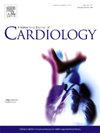Interleukin-1 blockade in patients with ST-segment elevation myocardial infarction with and without history of coronary artery disease
IF 3.2
2区 医学
Q2 CARDIAC & CARDIOVASCULAR SYSTEMS
引用次数: 0
Abstract
Background
Patients with a history of coronary artery disease (CAD) presenting with ST-elevation myocardial infarction (STEMI) have high risk. We aimed to determine whether patients with CAD history presenting with STEMI had greater systemic inflammation and/or whether they benefitted similarly from IL-1 blockade.
Methods
We pooled data from three randomized clinical trials, including 139 patients with STEMI treated with anakinra or placebo. Patients were stratified by history of CAD defined as prior documented CAD, MI or coronary revascularization. The area under the curve (AUC) for C-reactive protein (CRP) was used to assess systemic inflammation. Event-free survival defined as the time from enrollment to the occurrence of a predefined adverse outcome, including new-onset heart failure, hospitalization for heart failure, or death, was compared using Cox regression analysis.
Results
Of the 139 patients, 113 (81 %) had no history of CAD, while 26 (19 %) had a history of CAD. The CRP-AUC was significantly lower in the anakinra group compared placebo, independent of history of CAD: 85 [47–137] vs. 349 [154–580] mg·day/L for anakinra and placebo, respectively, in patients with history of CAD, and 86 [43–179] vs. 213 [115–341] mg·day/L in patients without CAD history; p for interaction = (0.27). No significant interactions were found between history of CAD and treatment allocation for the composite outcome for patients with and without history of CAD, respectively, p for interaction = (0.48).
Conclusion
IL-1 blockade with anakinra in STEMI leads to similar reductions in systemic inflammation and improvement in HF-related outcomes inpatients both with and without history of CAD.
有无冠状动脉疾病史的st段抬高型心肌梗死患者的白细胞介素-1阻断
背景:有冠状动脉疾病(CAD)病史的患者合并st段抬高型心肌梗死(STEMI)的风险较高。我们的目的是确定有冠心病病史的STEMI患者是否有更大的全身性炎症和/或他们是否同样受益于IL-1阻断。方法:我们汇集了来自三个随机临床试验的数据,包括139例接受阿那白或安慰剂治疗的STEMI患者。患者根据CAD病史进行分层,定义为先前记录的CAD,心肌梗死或冠状动脉血运重建术。c反应蛋白(CRP)曲线下面积(AUC)用于评估全身性炎症。无事件生存期定义为从入组到出现预定不良结局(包括新发心力衰竭、因心力衰竭住院或死亡)的时间,使用Cox回归分析进行比较。结果:139例患者中,113例(81 %)无冠心病病史,26例(19 %)有冠心病病史。与CAD病史无关,阿那金组CRP-AUC显著低于安慰剂组:有CAD病史的患者阿那金组和安慰剂组CRP-AUC分别为85[47-137]和349 [154-580]mg·天/L,无CAD病史的患者CRP-AUC分别为86[43-179]和213 [115-341]mg·天/L;相互作用P值 = (0.27)。在有和没有CAD病史的患者中,CAD病史和治疗分配之间没有发现显著的相互作用,相互作用的p值 = (0.48)。结论:在STEMI患者中,阿那白拉阻断IL-1可导致全身炎症的类似减少,并改善有或没有CAD病史的患者的hf相关结局。
本文章由计算机程序翻译,如有差异,请以英文原文为准。
求助全文
约1分钟内获得全文
求助全文
来源期刊

International journal of cardiology
医学-心血管系统
CiteScore
6.80
自引率
5.70%
发文量
758
审稿时长
44 days
期刊介绍:
The International Journal of Cardiology is devoted to cardiology in the broadest sense. Both basic research and clinical papers can be submitted. The journal serves the interest of both practicing clinicians and researchers.
In addition to original papers, we are launching a range of new manuscript types, including Consensus and Position Papers, Systematic Reviews, Meta-analyses, and Short communications. Case reports are no longer acceptable. Controversial techniques, issues on health policy and social medicine are discussed and serve as useful tools for encouraging debate.
 求助内容:
求助内容: 应助结果提醒方式:
应助结果提醒方式:


